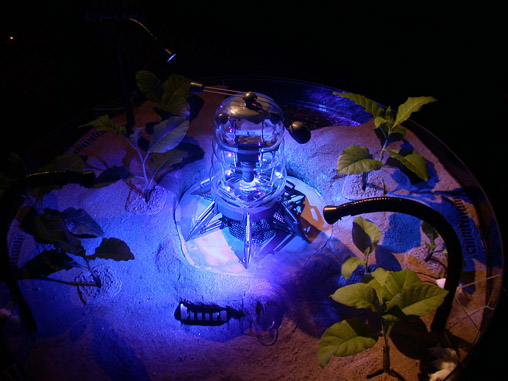The Eighth Day
2001
Back to The Eighth Day main page
The Eighth Day premiered at Arizona State University from October 25 to November 2, 2001.



The Eighth Day is a transgenic artwork that investigates the new ecology of fluorescent creatures that is evolving worldwide. I developed this work between 2000 and 2001 at the Institute for Studies in the Arts, Arizona State University, Tempe. While fluorescent creatures are being developed in isolation in laboratories, seen collectively they form the nucleus of a new and emerging synthetic bioluminescent system. The piece brings together living transgenic life forms and a biological robot (biobot) in an environment housed under a clear 4 foot diameter Plexiglas dome, thus making visible what it would be like if these creatures would in fact coexist in the world at large.


The Eighth Day presents an expansion of biodiversity beyond wildtype life forms. As a self-contained artificial ecological system it resonates with the words in the title, which add one day to the period of creation of the world as narrated in the Judeo-Christian Scriptures. All of the transgenic creatures in "The Eighth Day" are created through the cloning of a gene that codes for the production of green fluorescent protein (GFP). As a result, all creatures express the gene through bioluminescence visible with the naked eye. The transgenic creatures in "The Eighth Day" are GFP plants, GFP amoeba, GFP fish, and GFP mice.

A biobot is a robot with an active biological element within its body which is responsible for aspects of its behavior. The biobot created for "The Eighth Day" has a colony of GFP amoeba called Dyctiostelium discoideum as its "brain cells". These "brain cells" form a network within a bioreactor that constitutes the "brain structure" of the biobot. When amoebas divide the biobot exhibits dynamic behavior inside the enclosed environment. Changes in the amoebal colony (the "brain cells") of the biobot are monitored by it, and cause it to move throughout the exhibition. The biobot has six legs. When the amoeba move in the direction of a given leg, that leg contracts, causing the biobot to lean forward. Often one leg will contract while another will stretch back to its original position, creating a more complex sequence of movement. Ascending and descending motion becomes a visual sign of amoebal activity. The biobot also functions as the avatar of Web participants inside the environment. Independent of the ascent and descent of the biobot, Web participants are able to control its audiovisual system with a pan-tilt actuator. The autonomous ascent and descent motion provide Web participants with a new perspective of the environment.


The biobot has a biomorphic form and the "amoebal brain" is visible through the transparent bioreactor. In the gallery, visitors are able to see the terrarium with transgenic creatures from outside and inside the dome, as a computer in the gallery gives local visitors an exact sense of what the experience is like on the Internet. By enabling participants to experience the environment inside the dome from the point of view of the biobot, "The Eighth Day" creates a context in which participants can reflect on the meaning of a transgenic ecology from a first-person perspective.




Some of the images above had white light added for photographic clarity. The actual The Eighth Day artwork does not include white light.
Selected Bibliography on The Eighth Day
The Eighth Day team: Sheilah Britton, Producer, Gene Cooper, Web design and development, Charles Kazilek, Visualization, Assegid Kidané, Biobot Imaging and Control Hardware Design, David Lorig, Biobot design and fabrication, George Pawl, Installation design and fabrication, Kelly Phillips, Installation design and fabrication, Jeanne Wilson-Rawls, Biologist, Jeffery Alan Rawls, Biologist, Anish Adalja, Graphic design, Sree Chattergee, Office assistant, Oguzhan Cifdaloz, Biobot Camera Control Hardware Design, Patricia Clark, Video editing, Dan Collins, ISA Interim Director (2000-2001), Matt Coon, Fabrication assistant, Barbara Eschbach, Computing Commons Gallery Director, Isa Gordon, Fabrication assistant, photographer, Steven Kostell, Videographer, video editing, Richard Loveless former ISA Director (1991-2000), Grant Orvis, Biology assistant, Emily Puthoff, Fabrication assistant, Jennifer Pringle, Publicity, Bonnie Rigmaiden, Administrative Assistant, Thanassis Rikakis, ISA Director, Frances Salas, Business Manager, James Stewart, Biobot 3D modeling, Anna Vida, Production assistance, videographer. Special thanks to: Dale Denardo, University Veterinarian, ASU Glass Shop, Jim Campbell, Consultant, and Factor II, Inc., Consultants. Additional thanks to Andras Nagy, Samuel Lunenfeld Research Institute, Toronto; Richard Firtel, University of California, San Diego; Chi-Bin Chien, University of Utah, Salt Lake City, and Neal Stewart, University of North Carolina at Greensboro.
The Eighth Day team would not have been possible without everyone listed above. The Eighth Day team was developed through a two-year residency (2000-2001) at the Institute of Studies in the Arts, Arizona State University, Tempe.